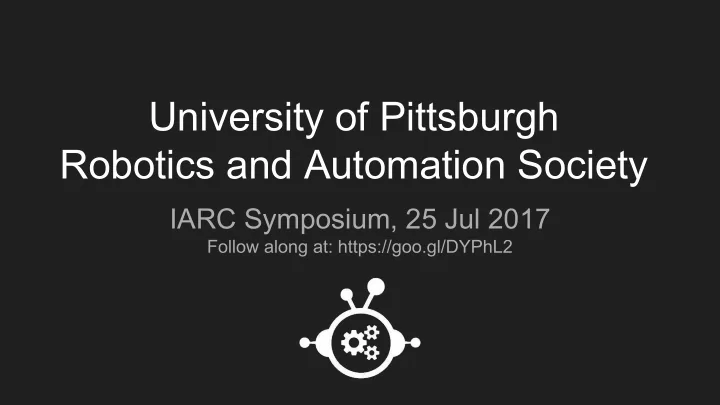

University of Pittsburgh Robotics and Automation Society IARC Symposium, 25 Jul 2017 Follow along at: https://goo.gl/DYPhL2
Outline Mechanical Design ● Prop guards ● Center frame ● Shock absorption Electrical Systems Software Systems ● Localization ● Motion Control ● Obstacle Detection/Avoidance ● Ground Robot Detection
Mechanical Design ● Durability ● Crash resilience ● Tolerance of rough landings ● Easy to rebuild ● Quick Facts ○ ~4.5kg (10lbs) ○ 8 minute flight time ○ 1.1 meters across ○ 12x6 APC props ○ 4 g/W ○ 3kW max power usage
Prop Guards ● Ten 3D printed parts ● Printed for strength ● Designed to fail without breaking carbon fiber ● Drone bounces off walls
Center Frame ● A normal load to tube's axis breaks plastic parts first Shown without top plate
Landing Gear Compression springs for shock absorption Low friction sliding pads to lessen horizontal stress on frame Plungers to detect ground contact
The 50 ft. crash onto cement ● Plastic brackets failed properly ● Carbon fiber was protected ● Minor damage to electronics ● Minor scratches on props (except one) ● Blew bearing on one motor ● Rebuilt in 3 days ● Grounded until e-kill was finished
Electronic Systems
Electronic Systems Main computer: Secondary computers/microcontrollers: ● NVIDIA Jetson TX2 ● Seriously Pro Racing F3 EVO ○ Advantages: ○ Cortex M3 Flight Controller ■ 256 CUDA cores board with integrated IMU ■ Low power consumption relative ● Raspberry Pi 3 to computational abilities ○ Expanded USB2.0 bandwidth ○ Disadvantages: ● Teensy 3.2 ■ Slow CPU compared to Intel ○ Hard real-time requirements NUC ○ Expanded GPIO ● Arduino Nano ○ Measures motor battery voltage and relays over opto-isolated serial link
Software System Nodes ● Velocity controller (low-level motion controller) ● Motion planner ● Abstract ● Obstacle Detector ● Extended Kalman Filter (robot_localization) ● Node monitor (iarc7_safety_node) ● Vision ● Orientation filter ● Velocity filter ● Altimeter reading nodes
Localization Vertical Orientation ● Long-range lidar ● IMU onboard flight controller, ● Short-range lidar fused with Mahony filter ● Landing gear switches ● Grid orientation fused with ● Accelerometer complementary filter Horizontal Fusion ● Accelerometer ● 15DOF Extended Kalman Filter ● Sparse Optical Flow (OpenCV (robot_localization) Lucas-Kanade) ● Complementary filters fusing velocities
Localization Future enhancements: ● Decoupled 3DOF Kalman filter for each spatial direction ● Fix bug in grid offset detector to stop drift in position estimates from integrating optical flow ● Localize using ground robot positions using some form of SLAM with DATMO
Motion Control Takeoff Controller ● Throttle ramp on startup until propellor thrust is equal to drone weight ● Calibrate thrust model for current drone weight ● Handoff to in-flight PID controllers
Motion Control Task Server ● Wraps high-level tasks such as waypoints and ground robot tracking ● Ensures safe requests from tasks Future Enhancements: ● Add enforceable protocols for handoffs between tasks
Obstacles Detection ● Based on data from RP-Lidar A2 planar scanning lidar ● Points are split into clusters based on their distances from each other, and each cluster is then fit to a circle using a nonlinear least squares optimizer Avoidance ● Velocities which would bring the drone within a specified radius of any obstacle within a specified small amount of time are prohibited by the task server
Ground Robots Rough position estimates are extracted from the camera images using a detector for the colored top plates as follows: ● Median blur ● HSV slice ● Find contours enclosing resulting blobs ● Calculate contour bounding boxes
Bottom Camera Ground Robot Detector For the bottom camera, the estimates as calculated from the bounding boxes are then fed into a Generalized Hough Transform to refine the estimates Future Enhancements: ● Built statistical prediction model to integrate ground robot and obstacle information and predict likely future states of all robots in the arena ● Use stereo cameras to provide obstacle detection in all directions
The Simulator Based on MORSE, the Modular OpenRobots Simulation Engine. Features: ● Simulates all hardware sensors ● Physics Engine ● Realistic textures ● Virtual cameras ● Ground truth sensors available to allow individual software components to be tested. ● Includes virtual roombas
Thank you! To our friends and family, those who listened, and our sponsors!
More Parts and Stats Motors: KDE 2814XF-515 ESCs: KDEXF-UAS35 Props: 12x6 Fiber Reinforced Nylon (APC) Peak Power Dissipation: ~24V * ~30A * 4 motors = ~3kW Batteries: ● ChinaHobbyLine 8Ah 30C ● 2x Tattu 5.2Ah 15C ● MultiStar 8Ah 10C
Recommend
More recommend